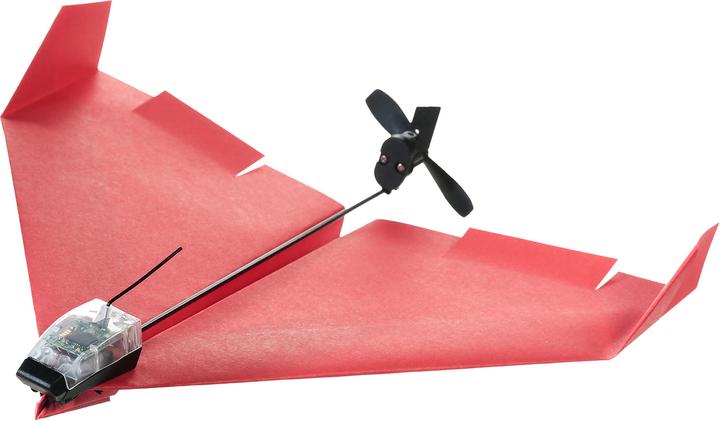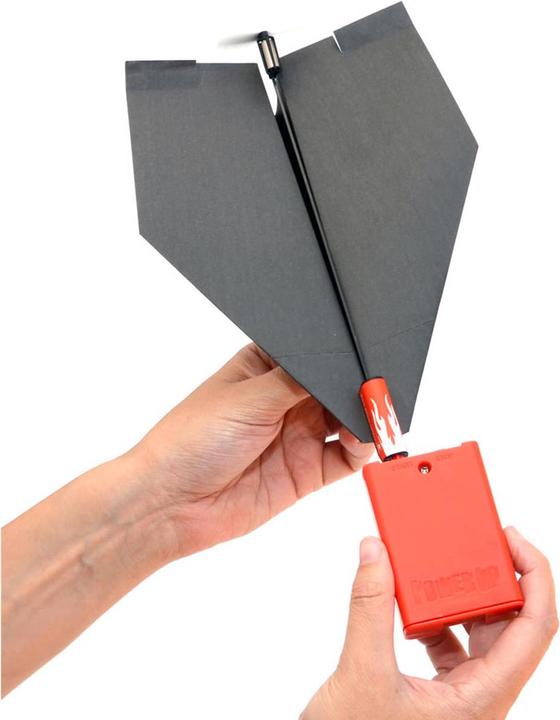

PowerUp Dart: Flying between frustration and euphoria
"Aerobatics with a paper aeroplane! How is that possible?" That's what I thought when I came across the PowerUp Dart crowdfunding project. "I could still realise my childhood dream of a remote-controlled aeroplane!" I thought to myself and supported the project. Read my experience report to find out whether the PowerUp Dart is any good.
At the beginning of February, I received the PowerUp Dart in my letterbox. And in duplicate. Why? Because I can never wait when I see something great. When I told my wife about the aerobatic paper aeroplane last year, she thought it would make a great Christmas present for me. Of course, I spoilt her surprise by ordering the set with two PowerUp darts myself. Anyway, now I have four darts, so hopefully four times the fun. Each dart comes stylishly presented in a plastic box. Included in it are:
- One Dart (the flight module consisting of motor, propeller and carbon fibre frame)
- Two paper templates for the Invader model (more on this later)
- One replacement propeller
- Instructions
Before I write more about the Dart, I would like to say a few words about flying.
The dream of flying

The dream of flying is probably as old as mankind itself. Even in Greek and Norse mythology, there is talk of people building wings in search of freedom. Incidentally, these stories usually end in disaster. However, we humans have not let this deter us: Today, we have conquered the skies and many people, at least in our latitudes, can afford to fly (even if only as passengers). Flying exerts a huge fascination on us. It is this fascination that motivates us to keep inventing new flying machines. These days, they don't even have to be passenger aircraft. The drone boom of recent years is an example of this. And now come the remote-controlled paper aeroplanes.
No fear of crashes
The idea of the remote-controlled paper aeroplane is not new. The inventor, Shai Goitein, has already developed several such paper aeroplanes. The earlier models are available from us (see at the end of the article). What is new about the PowerUp Dart is that it can be used to perform aerobatic tricks. The idea is definitely not new either: remote-controlled aerobatic aeroplane models have been around for decades. So what makes the Dart so special? Firstly, there's certainly the price: I paid 69 dollars plus shipping for my Perk. You won't find a drone or an aerobatic model for that price. What's more, the Dart is virtually indestructible and if the paper tears, you can simply fold a new paper aeroplane. The Dart is made for crashes and falls. That's very important to me.
Trauma
As I mentioned at the beginning, a remote-controlled aeroplane was a childhood dream of mine. Why did I never fulfil this dream? On the one hand, it's because I simply didn't have the money. On the other hand, it's because of one of my childhood traumas (yes, I'm telling you the story now!). For Christmas (I can't remember exactly how old I was) I was given a remote-controlled ship (the poor man's aeroplane). Despite the cold temperatures, my father drove me to the nearest dredging lake so that I could do a few laps with my ship. Unfortunately, my joy didn't last long: I steered the ship into the nearest shelf and it soaked off, like my remote-controlled dreams, which lie at the bottom of the lake until now (sorry for the schoolboy prose). I still haven't recovered from the shock and even remember exactly where the ship sank (on the map in the top left-hand corner, by the tree sticking out into the water 😭). I was probably pretty inept when it came to controlling remote-controlled devices. Now, over 25 years later, it's time to face up to this childhood trauma. At least in the light version, the PowerUp Dart shouldn't break so quickly.
Tinkering session
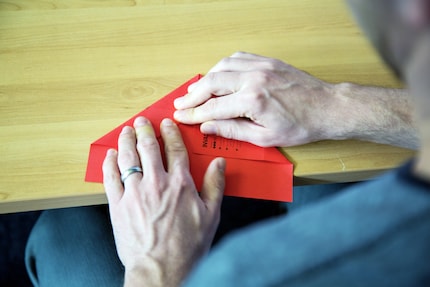
Before I can attempt my first flight, I have to do three things: Load the module, download the app to control it and connect it to the module and, most importantly for the eye, fold the aircraft.
Complete charging takes around 25 minutes according to the instructions. This should give you up to eight minutes of air time. An indicator light provides information about the charging process. For me, it takes less than ten minutes to fully charge. I download the app from Google Play (the app is available for Android and iOS). The Dart is connected via Bluetooth and can be controlled remotely from up to 60 metres away. The connection works very well if my Bluetooth firewall doesn't interfere. Which is why I deactivate it for the time being. For a first test, I let the propeller turn and steer the rudder (more on this later). Everything works so far. But the best aeroplane engine won't take off if it has no wings.
For my first remote-controlled paper aeroplane, I'm using A5 template paper for the sake of simplicity (the PowerUp Dart is designed exclusively for A5 paper). This can be used to fold the Invader model. The enclosed instructions also contain the folding instructions for this model. According to the description, it is characterised by good manoeuvrability. But it is not so fast. So it's perfect for a beginner like me. The instructions are easy to understand and it takes me about five minutes to build the Invader. There are also video folding instructions on the homepage. In some places, the paper and the module have to be fixed with adhesive tape. Before I assemble the dart, I want to test the flight behaviour, which is also recommended. Because if the paper aeroplane doesn't fly without the dart, it won't fly with the dart either. Apparently I haven't forgotten anything since primary school: the paper aeroplane stays well in the air. Now I just have to mount the dart and nothing stands in the way of my first flying lesson.
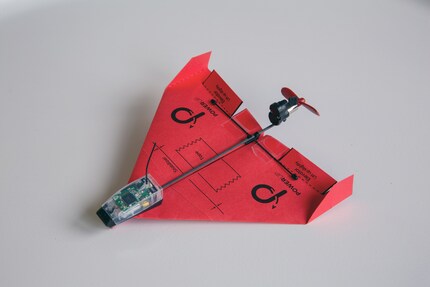
First flight tests
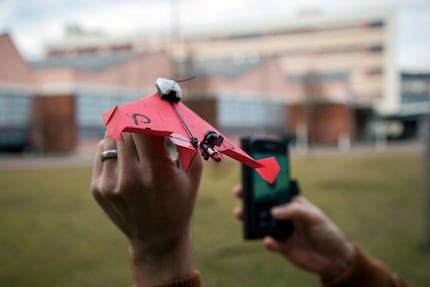
I feel a bit like aviation pioneer Otto Lilienthal, who was probably the first person to successfully fly in a glider. Fortunately, I'm only holding my smartphone and not flying myself. Lilienthal died during one of his flight attempts. I make my first flight attempt with the PowerUp Dart in front of our company headquarters. The temperature is below zero and the wind is blowing quite strongly. I'm holding the smartphone in my right hand and the paper aeroplane in my left.
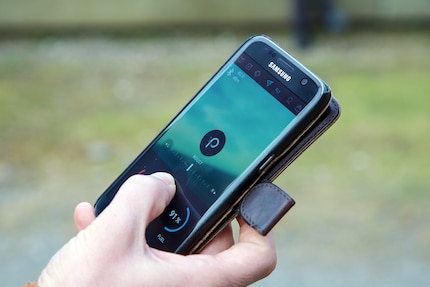
Before I write about my first short experiment, I'll briefly explain how the controls work. You accelerate using a virtual slider on your smartphone. This allows you to control the speed precisely, which is important for the tricks. It also has a boost button that immediately reaches 100 per cent power. Left/right is controlled by tilting the smartphone in the corresponding direction. You could also control the dart with a gamepad mode. To do this, hold the smartphone horizontally. Instead of using the gyrometer, you control the dart with left/right movements on a slider, similar to the throttle. I never needed the gamepad control during my test. As a left-hander, I throw the aircraft with my left hand and because the throttle slider is on the left-hand side, I can't accelerate with my thumb.
The propeller reacts to my inputs and the rudder also turns. I throw the dart like any other paper aeroplane. And indeed: it flies! Unfortunately, it doesn't last very long - after a few seconds, it lands rather roughly on the ground. I don't get the impression that the dart can be controlled. This may be because the wind is blowing too strongly or the glider is not yet optimally trimmed. But it's too cold for me on this day and I leave it at a few initial short flight attempts.
Brr
During my test, the Siberian cold has Switzerland firmly in its grip. Nevertheless, I set off on a Sunday to make further attempts at flying. The breeze was bitterly cold that day. So even on my second attempt, a strong wind is blowing. But I finally want to perform tricks with my paper aeroplane! The only tricks I manage to pull off on this day are nosedives. Whether it's the PowerUp Dart or me, I don't know. Frustrated by this, I take another look at the page of the Kickstarter. What strikes me immediately is that the project has over 1800 comments (as of 25 February 2018). This either means that the project is very well received or not. A look at the comments shows that most commenters have problems with the delivery. Either they did not receive their product or it arrived broken. There are also some comments that describe the paper aeroplane as unusable. So I'm not the only one with problems. I decide to remain as unbiased as possible and postpone further testing. Perhaps it will work better with less to no wind.
Uncontrollable
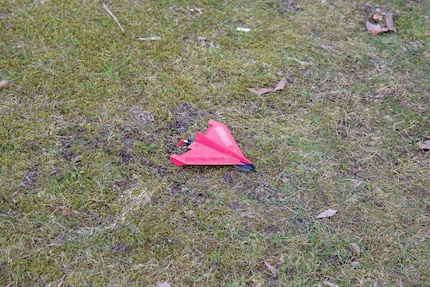
At the beginning of March, the weather finally improves. According to the weather forecast, the wind is only blowing at around 3 km/h. Time to make further attempts at flying. I head to the nearest meadow with the fully charged PowerUp Dart. After connecting, I step on the gas and throw the dart into the air.
As with the first flight attempts, the PowerUp Dart actually flies. It stays in the air for up to 30 seconds at a time. That's amazing, because the paper aeroplane can't really be controlled. It's like taking an untrained dog for a walk. No matter how much I tilt the smartphone in the right direction, the aeroplane does what it wants. Watching it soar through the air like that still puts a smile on my face. I still don't do any tricks, but my swoops from what feels like ten metres into the grass, concrete walls or trees are no less spectacular. And the Dart lives up to its promise: all I have to do is bend the paper back into shape and I can carry on flying. There are also trimming instructions in the app. As my dart doesn't want to fly properly, I follow the instructions. But that doesn't help either, I still can't control the paper aeroplane properly.
Tinkering lesson the second

The fact that I can't control the PowerUp Dart bothers me, of course. Basically, I have a paper aeroplane with a motor. It's cool too, but I want a remote-controlled aeroplane and not an uncontrollable rocket. I read up again to see if there might be a trick to get even more control over the aeroplane. After a short search, I find what I'm looking for from the inventor himself: Shai Goitein recommends attaching adhesive tape to the rudder. As the rudder now has more surface area, the dart should react more sensitively to inputs.
I try again with the larger rudder. Somehow, nothing seems to work anymore. The Dart spins uncontrollably. I decide to return the rudder to its normal position and trim the paper again. But that doesn't help either. The paper aeroplane cannot be tamed. On closer inspection, I realise that my many crashes have taken their toll on the paper. The keel is cracked and the nose is doing a Conor McGregor impression. It's probably time to take my paper to the recycling centre and fold a new plane. This time I'll take my time folding it and make sure I'm not a millimetre off. Let's see if I have more success now. So that I have a comparison, I'm going to get the PowerUp 3.0 (one of the predecessor models) from our product management team at Galaxus. Let's see how the two models compare.
Enchantment
I set about my next test in high spirits. I have already made up my mind: These are my last flight attempts for this experience report. As if the dart had heard me, it actually takes off on the first throw and I can steer left and right. And that's not all: if I give it full throttle, it even does a loop. If I let off the throttle, steer in one direction and then accelerate again, the Dart performs barrel rolls. Admittedly, this doesn't always work, but I can reproduce the manoeuvres, except for the loop. Inside, I'm jubilant with joy. At last I'm closer to my boyhood dream of flying. But this time, too, I have some sobering attempts. Sometimes the Dart spins to the ground on take-off. But that doesn't bother me at the moment. After each landing, I run after the dart like a dog after a ball, pick it up and try to get it flying again. It's great fun! I also let the battery through for the first time that day. Eight minutes of air time can go by so quickly. Flying the PowerUp Dart takes a lot of patience and practice. For example, I don't have to throw the glider too hard to take off: A light throw is enough and the motor does the rest. I'm glad that it's working reasonably well now and I'm already looking forward to the next flying lessons.
Comparison
Now I still want to know whether the Dart is actually an improvement on the PowerUp 3.0. The module is the same for both models. However, the carrier bar of the 3.0 is longer because it is made for A4 paper. This also makes the PowerUp 3.0 more vulnerable to the wind and less sleek. This is also evident in my test. Although the 3.0 has more lift when it is windy, without wind it tends more towards the ground (even after extensive trimming). In contrast to the Dart, it seems very sluggish, which also has an influence on the steering. By the time it reacts to inputs, it is already on the ground again. The PowerUp Dart is a lot more fun
.
Conclusion
Despite initial disappointment, I am delighted after my last few successful attempts. Even if there were always setbacks during my tests. It is very frustrating when I spend a few minutes trimming and then the dart spins to the ground right after the start. Or the Dart can't be controlled for some reason. When everything works, it's all the better for it. For example, when I do barrel rolls with the dart at dizzy heights twenty or thirty metres away. But also when it hits the ground vertically, I briefly straighten the paper and can then fly on. Maybe it's because I can finally see my boyhood dream whizzing through the air, but I would support the PowerUp Dart again in a heartbeat and can't understand the negative comments on the Kickstarter page. Admittedly, the PowerUp Dart doesn't fly perfectly and the app still suffers from teething problems. For example, I have often lost the Bluetooth connection or had to restart the app because the rudder could no longer be controlled. Nevertheless, it's great to fly with the Dart and my inner and outer child is looking forward to many more flying lessons and to mastering the Dart.
From big data to big brother, Cyborgs to Sci-Fi. All aspects of technology and society fascinate me.
From the latest iPhone to the return of 80s fashion. The editorial team will help you make sense of it all.
Show all